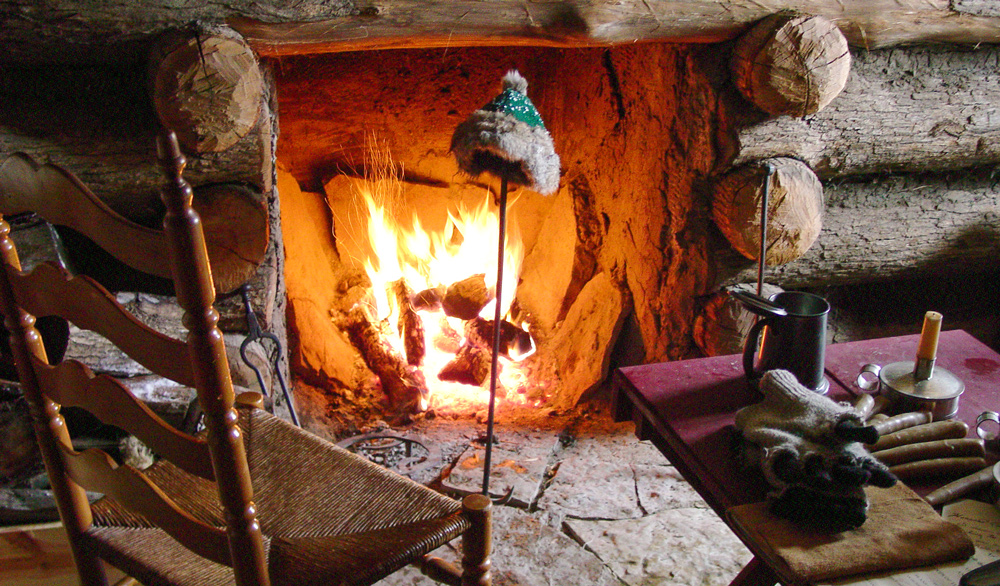Clark attends a ball in St. Louis or Cahokia while Lewis remains at winter camp at Wood River to complete work. Elsewhere, Founders James Madison and James Monroe debate the location of Louisiana’s northern boundary.
Camp River Dubois
Photo provided by Lewis & Clark State Historic Site, Hartford, Illinois. Used by permission.
Lewis Misses the Ball
Camp at River Dubois.
Feby. 18th 1804.My Dear Friend,
. . . being disappointed in geting down to the ball on the 14th and finding more to do when I began to look about me than I had previously thought of I determined it would be as well to go to work and pospone my visit to Cahokia & St. Louis a few days.
. . . .
M. LEWIS. Capt. &c.[1]Lewis to Clark. Donald Jackson, ed. Letters of the Lewis and Clark Expedition with Related Documents: 1783-1854, 2nd ed., (Urbana: University of Illinois Press, 1978), 167.
Debating the Northern Boundary
Department of State February 14th 1804
Sir [James Monroe],
There is reason to believe that the boundary between Louisiana and the British territories north of it were actually fixed [by] commissioners appointed under the Treaty of Utrich and that this boundary was to run from the Lake of the Woods westwardly in latitude forty nine in which case the Vth Article would be nugatory as the line from the Lake of the Woods to the nearest source of the Mississippi would run thro territory which on both sides of the line would belong to the United States. Annexed is a paper stating the authority on which the decision of the commissioners under the Treaty of Utrich rests and the reasoning opposed to the construction making the forty nine of latitude the northern boundary of Louisiana with marginal notes in support of that construction.
James Madison[2]Founders Online, National Archives, founders.archives.gov/documents/Madison/02-06-02-0439. [Original source: The Papers of James Madison, Secretary of State Series, vol. 6, 1 November 180–31 March … Continue reading
Weather Diary
Therm at rise
weather wind Therm at 4 Oclk weather wind River 15 above 0 fair S.W. 32 above 0 fair S.W. 1 ft. 1 in. but little drift ice, the Misipi is not broken up.
—Meriwether Lewis[4]To assist the reader, the editor of this web page has omitted the “day of month 1804” column, merged the “River” columns, and spelled out some abbreviations.
Experience the Lewis and Clark Trail
The Lewis and Clark Trail Experience—our sister site at lewisandclark.travel—connects the world to people and places on the Lewis and Clark Trail.
Plan a trip related to February 14, 1804:

Winter Camp at Wood River (Camp Dubois) is a High Potential Historic Site along the Lewis and Clark National Historic Trail managed by the U.S. National Park Service. The site, near Hartford, Illinois, is managed as Lewis and Clark State Historic Site and is open to the public.
In present St. Louis, the Jefferson National Expansion Memorial “commemorates Thomas Jefferson’s vision of the continental expansion of the United States” and is a High Potential Historic Site along the Lewis and Clark National Historic Trail managed by the U.S. National Park Service.
Notes
| ↑1 | Lewis to Clark. Donald Jackson, ed. Letters of the Lewis and Clark Expedition with Related Documents: 1783-1854, 2nd ed., (Urbana: University of Illinois Press, 1978), 167. |
|---|---|
| ↑2 | Founders Online, National Archives, founders.archives.gov/documents/Madison/02-06-02-0439. [Original source: The Papers of James Madison, Secretary of State Series, vol. 6, 1 November 180–31 March 1804, ed. Mary A. Hackett, J. C. A. Stagg, Ellen J. Barber, Anne Mandeville Colony, and Angela Kreider (Charlottesville: University of Virginia Press, 2002), 475–477.] |
| ↑3 | “Enclosure: Pickering’s Analysis of the Boundary between Louisiana and Canada, with Jefferson’s Notes,” Founders Online, National Archives, founders.archives.gov/documents/Jefferson/01-42-02-0260-0002. [Original source: The Papers of Thomas Jefferson, vol. 42, 16 November 1803–10 March 1804, ed. James P. McClure (Princeton: Princeton University Press, 2016), 293–301.] |
| ↑4 | To assist the reader, the editor of this web page has omitted the “day of month 1804” column, merged the “River” columns, and spelled out some abbreviations. |



